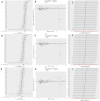No bidirectional relationship between inflammatory bowel disease and diverticular disease: a genetic correlation and Mendelian randomization study
- PMID: 38419785
- PMCID: PMC10899511
- DOI: 10.3389/fgene.2024.1334473
No bidirectional relationship between inflammatory bowel disease and diverticular disease: a genetic correlation and Mendelian randomization study
Abstract
Background: Although previous studies found that inflammatory bowel disease (IBD) and diverticular disease (DD) usually co-exist clinically, studies examining the relationship are spare. Aim: Our study aspires to investigate the causal correlation between the IBD [including ulcerative colitis (UC) and Crohn's disease (CD)] and DD using the Mendelian randomization (MR) analysis. Methods: We conducted a two-sample bidirectional MR analysis using publicly available genome-wide association studies (GWAS) summary data. The single nucleotide polymorphism (SNP) data associated with DD and IBD were obtained from the Finnish Biobank and UK Biobank, respectively. Through secondary data analysis of all GWAS summary data, we systematically screened genetic instrumental variables. To address the impact of horizontal pleiotropy, several methods were employed, including the inverse variance-weighted method (IVW), maximum likelihood method, Egger regression method, weighted median method, and simple median method. These approaches aimed to detect and correct for the potential bias caused by horizontal pleiotropy. Results: Genetically predicted DD did not have a causal effect on IBD (OR 1.06, 95% CI 0.98-1.17, p = 0.15), and had no causal effect on UC (OR 1.10, 95% CI 0.94-1.20, p = 0.36) and CD (OR 1.03, 95% CI 0.92-1.16, p = 0.62) either. Furthermore, in the reverse MR analysis, we did not observe any significant causal effect of IBD on DD. Results of complementary methods showed consistent results with those of the IVW method. Conclusion: This study's findings do not provide evidence for a causal relationship between IBD and DD, which contradicts the majority of observational studies.
Keywords: Crohn’s disease; Mendelian randomization; causality; diverticular disease; inflammatory bowel disease; ulcerative colitis.
Copyright © 2024 Aierken, Atabieke, Aierken, Li, Xia, Aizezi and Li.
Conflict of interest statement
The authors declare that the research was conducted in the absence of any commercial or financial relationships that could be construed as a potential conflict of interest.
Figures


Similar articles
-
Are neurodegenerative diseases associated with an increased risk of inflammatory bowel disease? A two-sample Mendelian randomization study.Front Immunol. 2022 Sep 8;13:956005. doi: 10.3389/fimmu.2022.956005. eCollection 2022. Front Immunol. 2022. PMID: 36159838 Free PMC article.
-
Causal association between inflammatory bowel disease and IgA nephropathy: A bidirectional two-sample Mendelian randomization study.Front Genet. 2022 Nov 16;13:1002928. doi: 10.3389/fgene.2022.1002928. eCollection 2022. Front Genet. 2022. PMID: 36467999 Free PMC article.
-
Inflammatory bowel disease and celiac disease: A bidirectional Mendelian randomization study.Front Genet. 2022 Aug 19;13:928944. doi: 10.3389/fgene.2022.928944. eCollection 2022. Front Genet. 2022. PMID: 36061176 Free PMC article.
-
The causal effects of inflammatory bowel disease on primary biliary cholangitis: A bidirectional two-sample Mendelian randomization study.Liver Int. 2023 Aug;43(8):1741-1748. doi: 10.1111/liv.15616. Epub 2023 Jun 7. Liver Int. 2023. PMID: 37283182
-
Relationship between inflammatory bowel disease and erectile dysfunction: a 2-sample Mendelian randomization study.Sex Med. 2024 Jan 23;11(6):qfad067. doi: 10.1093/sexmed/qfad067. eCollection 2023 Dec. Sex Med. 2024. PMID: 38264202 Free PMC article.
Cited by
-
Ulcerative colitis increases the risk of atrioventricular block: evidence from a Mendelian randomized analysis.Sci Rep. 2025 Apr 7;15(1):11873. doi: 10.1038/s41598-025-96111-6. Sci Rep. 2025. PMID: 40195464 Free PMC article.
-
Investigating the causal links among gut microbiome features, inflammation-related proteins, and diverticular disease: Insights from a mediation Mendelian randomization study.Medicine (Baltimore). 2025 May 30;104(22):e42676. doi: 10.1097/MD.0000000000042676. Medicine (Baltimore). 2025. PMID: 40441205 Free PMC article.
-
Impact of radiotherapy on survival outcomes in metastatic neuroblastoma a propensity score matched SEER database analysis.Sci Rep. 2025 May 2;15(1):15466. doi: 10.1038/s41598-025-99170-x. Sci Rep. 2025. PMID: 40316615 Free PMC article.
-
Investigating casual association among gut microbiome and esophageal cancer: A Mendelian randomization study.Medicine (Baltimore). 2025 Feb 21;104(8):e41563. doi: 10.1097/MD.0000000000041563. Medicine (Baltimore). 2025. PMID: 39993127 Free PMC article.
-
No bidirectional relationship between constipation and colorectal cancer in European and Asian populations: A Mendelian randomization study.Medicine (Baltimore). 2024 Oct 25;103(43):e40206. doi: 10.1097/MD.0000000000040206. Medicine (Baltimore). 2024. PMID: 39470562 Free PMC article.
References
-
- Burgess S., Scott R. A., Timpson N. J., Davey Smith G., Thompson S. G. EPIC- InterAct Consortium (2015). Using published data in Mendelian randomization: a blueprint for efficient identification of causal risk factors. Eur. J. Epidemiol. 30 (7), 543–552. 10.1007/s10654-015-0011-z - DOI - PMC - PubMed
LinkOut - more resources
Full Text Sources

